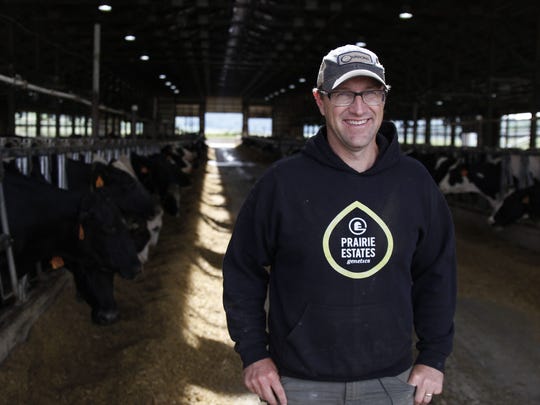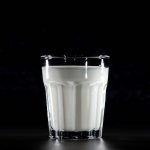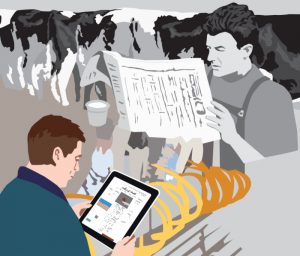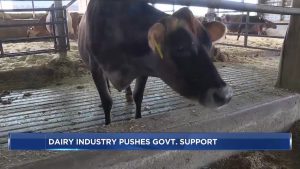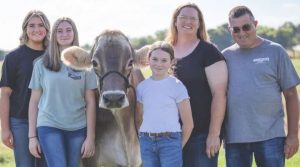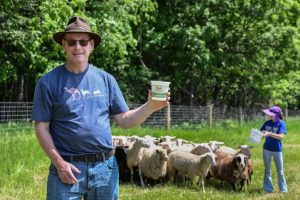
But one recent call stands out in Stephenson’s mind. A farmer he had spoken to before “Called to give me hell,” he recounted. “He called me while he was waiting to unload cows at the auction barn.”
The dairy farmer said he was tired of not being able to pay his bills and was seriously thinking about killing himself because he saw very little hope ahead.
“These are not the conversations we want to have, when farmers can’t pay their bills and they feel horrible about it.”
Stephenson said those kinds of sentiments are not unusual these days among dairy farmers. He told the story at a March 2 event in Sauk City, organized by the UW-Madison Alumni Association, which was attended by several hundred people. He noted that there are 35,000 to 40,000 dairy farmers across the United States and all are independent decision makers.
The seeds of today’s distress in dairy country lies in 2014, when prices were the highest they had been in a generation and those high prices “sent the signal to those dairy farmers that the market wants more of your product. So farmers kicked into gear,” he said, “and began producing more.”
Exports need to stay high – 17 to 18% of total milk production – in order to sustain the kind of dairy industry that we have, he noted. The trade wars and now the coronavirus outbreak have not helped dairy, Stephenson added.
Dairy farmer Mitch Breunig, who farms near Sauk City and opened his farm for tours as part of the UW Alumni event, said that today’s dairy farmers are in a situation where the lowest-cost producer tends to be the winner.
“The challenge of the last few years has been survival rather than investing in the future of the business,” Breunig said.
This downturn in dairy prices came quickly and has stayed for years. Banks may have said no to operating loans. Some farmers who are the sixth generation on their operations are those who are losing the farm.
“For some of my friends that’s their story,” Breunig said.
Kent Weigel, a livestock geneticist who is chair of the UW-Madison’s dairy science department, and who appeared with Stephenson and Breunig on the event’s panel, noted that a few decades ago Wisconsin had over 40,000 dairy farms and many of them had six or seven kids. Now it’s down to somewhere around 7,000 dairy farms with two kids apiece and that affects the dairy science enrollment, he said.
Stephenson commented that the peak number of dairy farms in Wisconsin (and the nation) came in the 1930s and farm numbers have been dropping since that time. However, it’s more typical for Wisconsin to lose 3 or 4% of its farmers in one year and last year the state lost 10%.
One of the concerns, which was highlighted by the recent Dairy Task Force 2.0, on which he serves as chairman, is that dairy farms form the foundation for the state’s rural communities, Stephenson said. Those farmers invest money locally and it cycles through those local economies. There is concern in the state about how the loss of dairy farms affects those rural communities.
Breunig said that 10 years ago when dairy farmers gathered they were proud of saying things like “we feed the world”.
“Today we’re more concerned about survival. We’re up every day to produce wholesome food and we hope it goes around the world,” he said.
In the last decade Breunig said it’s become difficult for farmers to set the record straight on social media when soccer moms and others bash the dairy industry.
“As more and more people get away from the farm it’s really hard to reach our consumers,” he said.
One of the efforts aimed at correcting the effect of the current trends in the dairy industry is the state’s Dairy Innovation Hub, a push to invest in the best dairy talent at the three state universities which have dairy science programs: UW-River Falls, UW-Madison and UW-Platteville.
“It’s an all hands on deck moment,” said Weigel. “We want to invest in innovation and get a step ahead of the competition in other states, drawing the best dairy talent to Wisconsin.”
The state’s push will be channeled into four areas – food and nutrition, environment, animal health and welfare and rural communities.
One of the ways to stem the tide of dairy losses of course is to get higher milk prices and there are two ways to do that – export more and consume more domestically.
“We eat a lot of cheese and we love it,” Stephenson said.
In the 1970s, U.S. consumers put away 14 pounds of cheese per capita and today that figure stands at 38 pounds per capita.
Since the state’s original Dairy Task Force, convened by then Gov. Tommy Thompson, issued its conclusions, Wisconsin has become a hotbed of specialty cheese production.
“We used to import most of our specialty cheese and now we make it here,” said Stephenson.
Breunig, who produces milk for Grande Cheese, a company that produces Italian specialty cheeses, said their goal is to come up with new products every year.
An important turning point for his farm was taking a financial literacy class.
“You’ve got to understand your books and find a niche in the industry,” he said.
In Breunig’s case, he markets some high-performing cattle and he does a quarterly business plan for his lender to see.
Weigel said that science has helped dairy farmers by making some of the new tools affordable, like genomic testing. When it first came out, the genetic tests were $250 and that wasn’t feasible for most operations. But when that science progressed and they figured out ways to do it for $40 per heifer it was far more useful to farmers.
“Cool tools don’t help if they’re not affordable,” Weigel said.
Also, the goal of genetics has changed over his career – from “pretty” cows to cows with longevity, Weigel said. For the last seven years dairy geneticists have been working on feed efficiency – cows that turn feed into milk more efficiently – using 6,000 cows across the UW system.
Breunig said his goal is to have “the invisible cow” – one that milks efficiently, breeds easily, has good components, calves by herself and doesn’t get sick. He prefers cows that are low to the ground and have strength rather than the taller, skinnier Holsteins of past decades. The newer-style cow has a smaller carbon footprint, he added.
Stephenson said genetics and farm management have produced “incredible improvement” in milk production per cow.
“We see successful farms in all sizes,” said Stephenson, although he noted that “small” farm definitions have changed over time. “It used to be 15 cows, now 100 cows is a small farm.
“And lest we despair, we are still producing more milk than we ever have before,” he added.
Several audience members asked about milk supply management programs and if they could have helped avert this crisis in Dairyland. Stephenson said that other industries have figured out how not to oversupply the market with their product – like Apple. In agriculture, the cranberry industry is one that has instituted supply management.
But in order for the dairy industry to get it done, they would have to come to Washington and speak with one voice.
“Can we get buy-in from a majority of the industry?” Stephenson said.
Asked if the trend of losing large numbers of farms is going to continue, Stephenson commented that it looked like this year there was going to be a significant price recovery
“And now another dirt ball got thrown at us,” he said, referring to the coronavirus.) “Some farmers are financially pushed out of business and others quit because they are just tired of the struggle. This can’t continue.”
Asked what citizens can do to help dairy farmers, Stephenson said they need to be supportive, understanding that farmers with slow tractors on the road have an important job to do, and “have an extra cheese platter – it’s a small thing but it counts.”
